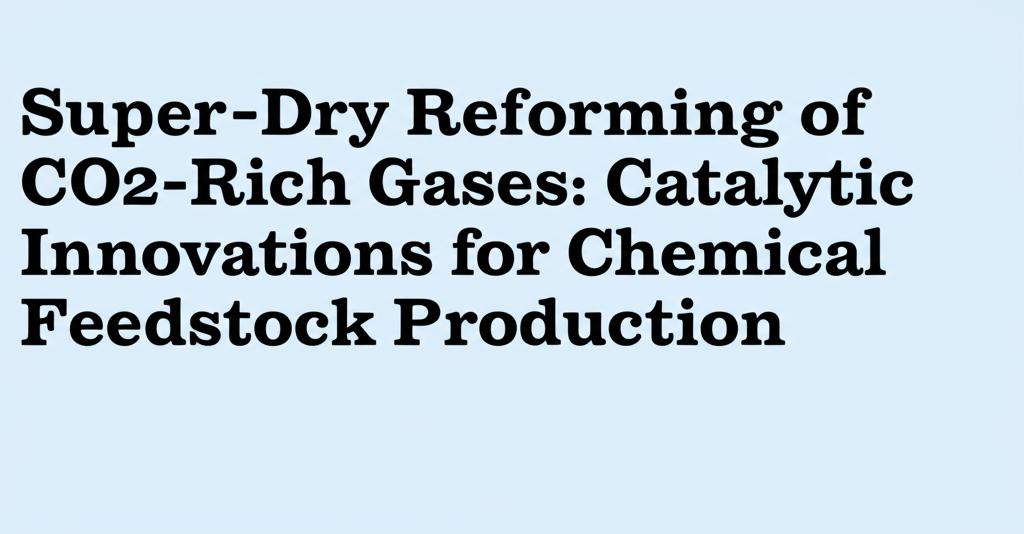The pursuit of sustainable chemical production in the face of mounting greenhouse gas emissions has driven significant research into CO2 utilization technologies. Among these, super-dry reforming (SDR) of CO2-rich gases, particularly methane-containing streams, is emerging as a promising pathway to produce valuable chemical feedstocks like syngas (a mixture of hydrogen and carbon monoxide). This process is distinguished from conventional dry reforming by its ability to handle feed gases with significantly higher CO2 to methane ratios (CO2/CH4 ≥ 2), potentially even utilizing up to three CO2 molecules per methane molecule. This intensification of CO2 conversion is crucial for effectively valorizing industrial off-gases and CO2-rich natural gas or biogas sources.
Recent breakthroughs are largely centered around innovative catalytic systems and process integration. One notable advancement involves the use of solid oxide electrolysis cells (SOECs) in a tandem electro-thermocatalytic process. This approach, operating at high temperatures (600-850°C), couples dry reforming of methane (DRM), the reverse water-gas shift (RWGS) reaction, and water electrolysis within the SOEC cathode. The in-situ electrochemical reduction of water, a byproduct, generates hydrogen and O2- ions. These ions migrate through the electrolyte to the anode, effectively driving the RWGS equilibrium forward. This enhances CO2 conversion and H2 selectivity beyond what's achievable by conventional thermodynamic limits.
Catalyst development within these systems is also a key area of innovation. For instance, researchers have successfully exsolved Rhodium (Rh) nanoparticles onto a Cerium dioxide (CeO2-x) support. This creates high-density Ce3+-VO-Rhδ+ interfacial active sites. These sites exhibit distinct roles: Rhδ+ sites are primarily responsible for methane dissociation, while the oxygen vacancy-rich Ce3+-VO-Rhδ+ interface promotes CO2 adsorption, activation, and the RWGS reaction. This same interface also catalyzes the electrochemical reduction of water, further boosting CO2 conversion and H2 selectivity.Remarkably, systems employing these catalysts and SOEC integration have demonstrated methane conversion rates of 94.5% and CO2 conversion rates of 95.0% when operating with a CO2/CH4 ratio of 4, achieving nearly 100% selectivity towards CO and H2. The apparent methane reducibility in such systems can reach its theoretical maximum.
Beyond electrocatalysis, chemical looping concepts for super-dry reforming are also advancing. These systems often employ a combination of a reforming catalyst (typically nickel-based), an oxygen carrier (often iron oxide-based), and a CO2 sorbent (like calcium oxide-based materials). In this process, a CO2-rich mixture of methane and CO2 is first reformed into syngas. This syngas then reduces the oxygen carrier, and the CO2 is captured by the sorbent. Subsequently, the oxygen carrier and CO2 sorbent are regenerated, often by temperature swings or sweeping with an inert gas, releasing a concentrated stream of CO. This cyclic operation allows for intensified CO2 utilization, theoretically converting up to three CO2 molecules per CH4 molecule. The key challenge in commercializing chemical looping SDR lies in the long-term robustness and economic viability of the oxygen carrier and sorbent materials under industrial conditions.
Researchers are also focusing on developing coke-resistant catalysts, as carbon deposition is a significant issue in methane reforming processes, especially at the high temperatures required. Strategies include designing catalysts with strong metal-support interactions, developing bimetallic catalysts (e.g., Ni-Co, Mo-Ni), using layered double hydroxides, and creating core-shell structured catalysts. For example, Mo-doped Ni nanocatalysts on defect-free single-crystal MgO have shown exceptional resistance to coking, even after extended operation. Atomically dispersed Ni on Ce-doped hydroxyapatite is another promising approach. The goal is to enhance catalyst stability and performance, thereby making the SDR process more economically feasible.
The potential impact of successful super-dry reforming technology is substantial. It offers a direct route to valorize CO2-rich gas streams, including industrial tail gases and biogas, into essential chemical building blocks. This not only contributes to mitigating greenhouse gas emissions but also provides a pathway to produce sustainable fuels and chemicals, thereby fostering a more circular carbon economy. As research progresses, addressing challenges related to catalyst durability, process scale-up, and integration with renewable energy sources will be critical for the widespread industrial adoption of super-dry reforming.

